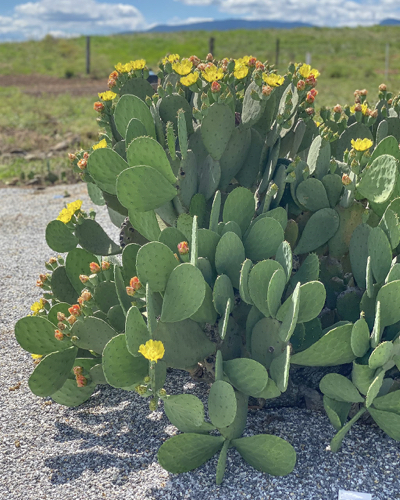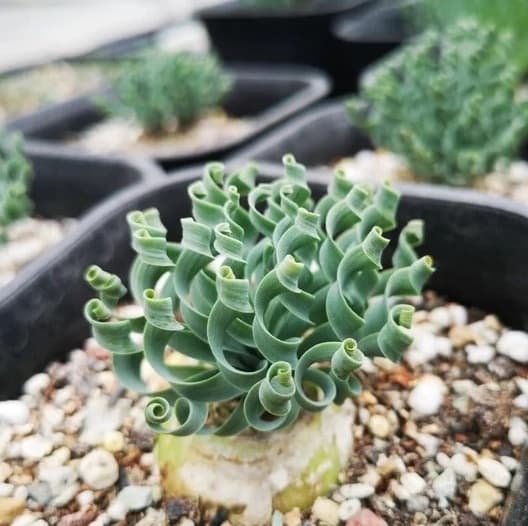Large Succulent Plants for Outdoors
Posted by Grace on October 23, 2023
When we think of succulent plants, we often picture those interesting small plants in various pots with colorful stones. But not all succulents are tiny. Some can grow really big, like trees in your garden.
In this article, we'll show you some of these giant succulents to amaze your guests and neighbors.
Contents
- Silver Yucca (Yucca filamentosa)
- Agave Americana (Century Plant)
- Mexican Fencepost Cactus (Pachycereus marginatus)
- Aeonium Cyclops
- Euphorbia trigona (African Milk Tree)
- Fouquieria splendens (Ocotillo)
- Stenocereus thurberi
- Aloe Vera
- Prickly Pear Cactus (Opuntia)
- Saguaro Cactus
Silver Yucca (Yucca filamentosa)

Original Habitat: Native to the southeastern United States, Silver Yucca thrives in arid regions with sandy or loamy soil. It's often found in coastal dunes, but it's adaptable to various conditions.
Height: Silver Yucca can reach impressive heights of up to 3 to 4 feet, making it a stunning focal point in your garden.
Preference of Climate: This succulent is well-suited to USDA hardiness zones 4 to 11, making it adaptable to a wide range of climates, from hot and dry to moderately cold areas.
Agave Americana (Century Plant)

Original Habitat: Agave Americana is native to arid regions of the southwestern United States, Mexico, and Central America. It typically grows in rocky, well-drained soil.
Height: These striking succulents can reach towering heights of 6 to 12 feet, with robust, silvery-blue foliage.
Preference of Climate: Century Plants are best suited for arid climates in USDA hardiness zones 8 to 10, making them perfect for desert landscaping.
Mexican Fencepost Cactus (Pachycereus marginatus)

Original Habitat: Native to Mexico, Pachycereus marginatus, also known as Mexican Fencepost Cactus, thrives in well-drained soil in desert regions.
Height: This cactus can grow up to 16 feet tall, forming slender, columnar shapes with distinct ribs and spines.
Preference of Climate: Pachycereus marginatus flourishes in hot and dry conditions, ideal for USDA hardiness zones 9 to 11.
Aeonium Cyclops

Original Habitat: Aeonium Cyclops is native to the Canary Islands and is often found growing in rocky, coastal areas.
Height: With its captivating rosette of succulent leaves, Aeonium Cyclops can reach heights of 3 to 4 feet.
Preference of Climate: It thrives in Mediterranean climates, making it an excellent choice for gardens in USDA hardiness zones 9 to 11.
Euphorbia trigona (African Milk Tree)

Original Habitat: This striking succulent hails from West Africa, where it prefers well-drained soils and plenty of sunlight.
Height: African Milk Trees can reach impressive heights of 6 to 8 feet, featuring distinctive vertical branches with spines.
Preference of Climate: This succulent enjoys warm, dry climates and is well-suited for USDA hardiness zones 10 to 11.
Fouquieria splendens (Ocotillo)

Original Habitat: Ocotillo is native to the arid southwestern United States and northern Mexico, often seen in the Sonoran Desert.
Height: This unique succulent grows in the form of tall, slender, spiny canes, reaching heights of up to 20 feet.
Preference of Climate: Ocotillo is a desert dweller, thriving in hot, dry climates typical of USDA hardiness zones 9 to 11.
Stenocereus thurberi

Original Habitat: Stenocereus thurberi, or Organ Pipe Cactus, is native to the Sonoran Desert of North America, favoring well-drained soils in arid regions.
Height: As its name suggests, this cactus forms multiple slender columns, which can grow up to 20 feet in height.
Preference of Climate: It thrives in desert environments and is best suited for USDA hardiness zones 9 to 11.
Aloe Vera

Original Habitat: Aloe Vera is native to the Arabian Peninsula but is now widely cultivated in various regions worldwide.
Height: Aloe Vera typically grows between 1 and 3 feet, featuring rosettes of fleshy leaves with healing properties.
Preference of Climate: Aloe Vera is adaptable to a variety of climates and is well-suited for USDA hardiness zones 9 to 11.
Prickly Pear Cactus (Opuntia)

Original Habitat: Native to North America, Prickly Pear Cactus thrives in well-drained soils in arid and semi-arid regions.
Height: This low-growing cactus can reach a height of 1 to 6 feet, with flat, pad-like stems and distinctive spines.
Preference of Climate: Prickly Pear Cactus is well-suited for USDA hardiness zones 4 to 11, making it a versatile choice for a range of climates.
Saguaro Cactus

Original Habitat: The iconic Saguaro Cactus is native to the Sonoran Desert of the United States and Mexico, often growing in sandy soils.
Height: Saguaro Cacti can be true giants, with some individuals reaching towering heights of 40 to 60 feet or more.
Preference of Climate: This impressive cactus is well-suited for hot and arid climates in USDA hardiness zones 9 to 11.






